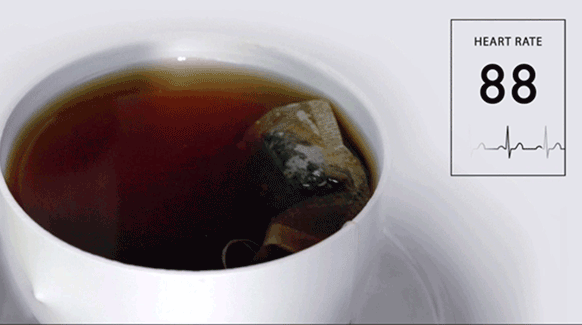For all the talk of smart objects, most of the stuff in our homes is remarkably dumb. Objects just sit there, inanimate and indifferent to the person using them. But just wait. According to Alex Rothera and James Krahe, it’s only a matter of time before even the dumbest of objects are embedded with a magical sense of interactivity. Eventually, the designers say, our stuff will be able to react to us based on data transmitted right through our bodies.
In Playful Self, a new project on display at Dublin Science Gallery’s Life Logging exhibition, the team uses banal objects---a tea set and phonograph---to demonstrate what it might be like if our objects could respond to physical touch. Each of the objects responds to a different signal of biometric data: A bowl of sugar rises and falls, mimicking your breath rate; a tea bag bobs up and down to the beat of your heart; a phonograph slows and speeds up based on skin conductance. It's pretty simple stuff for now, but it hints at an interesting future.
The underlying technology that allows this interaction to happen is based on research that Rothera was involved with at Disney Research. It centers around the idea of capacitive coupling with the human body, using the electricity naturally surging through our bodies to transfer electronic signals to inanimate objects. Imagine you have a wrist worn device that measures biometric data. Instead of transmitting that data using a power hungry Bluetooth connection or a cumbersome cable, your touch will effectively be a USB stick. In the case of Playful Self, the prototype objects all have a bit of metal to receive the currents.
You could theoretically use this data to make objects come to life in any number of ways. There is, of course, a bit of extra magic at play in Playful Self. In the case of the sugar pot, data gathered from a wrist-worn sensor actually controls a speaker that pulsates at the same rate as your breath. Magnets guide the tea bag up and down; a servo motor controls the phonograph. The team’s examples are more poetic than practical, meant to help you imagine how biometric signals could be used in design in the future. Imagine your car changing settings depending on whose gripping the wheel, or transferring files from your computer to your phone with your finger-tip.
Rothera’s real goal is trying to figure out how to make the digital world less digital. Today, screens are the intermediary between our bodies and objects---they help us comprehend the data that’s being gathered. “To know our heart rates through this very digital screen and then think about what that number means is really a three-step process,” he says. Rothera wants to cut out the middleman altogether. Doing so could lead to technology that responds to our bodies in all sorts of interesting new ways.

